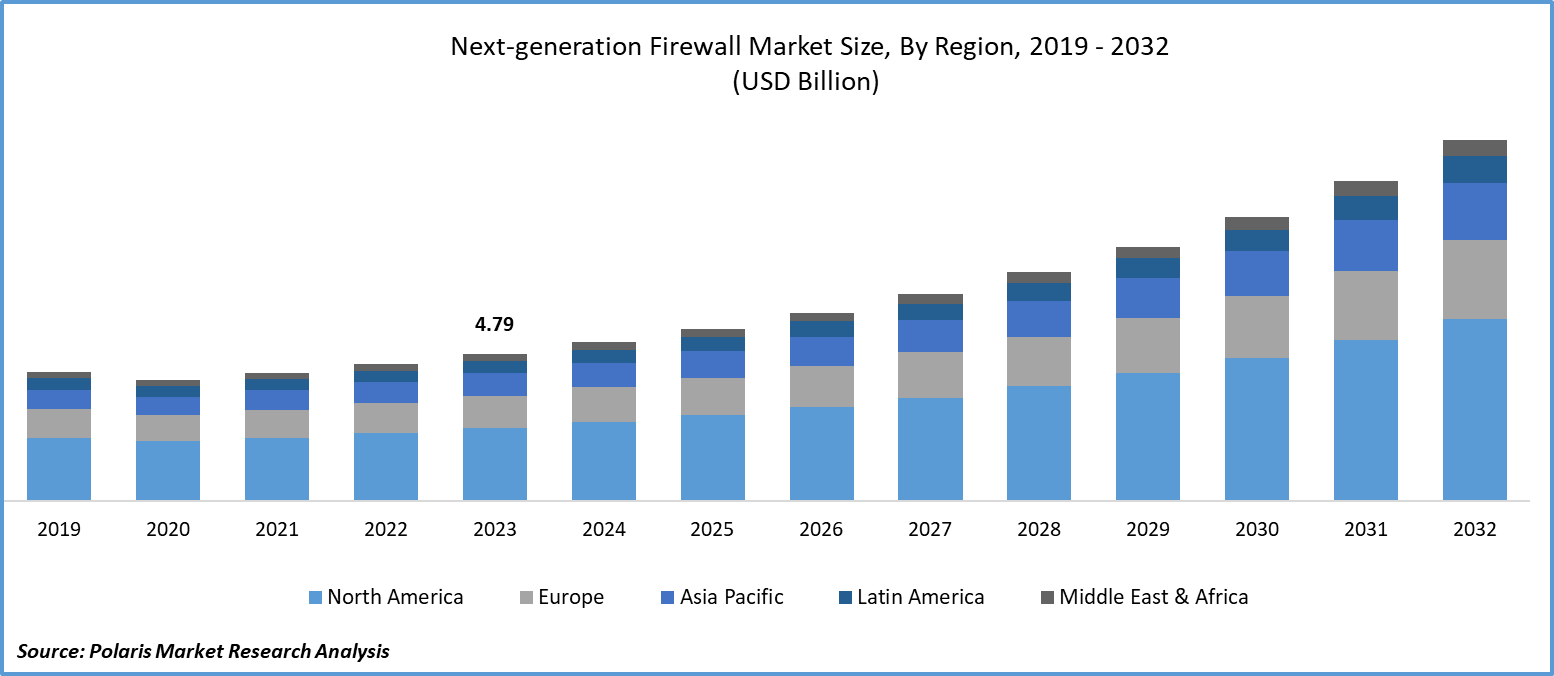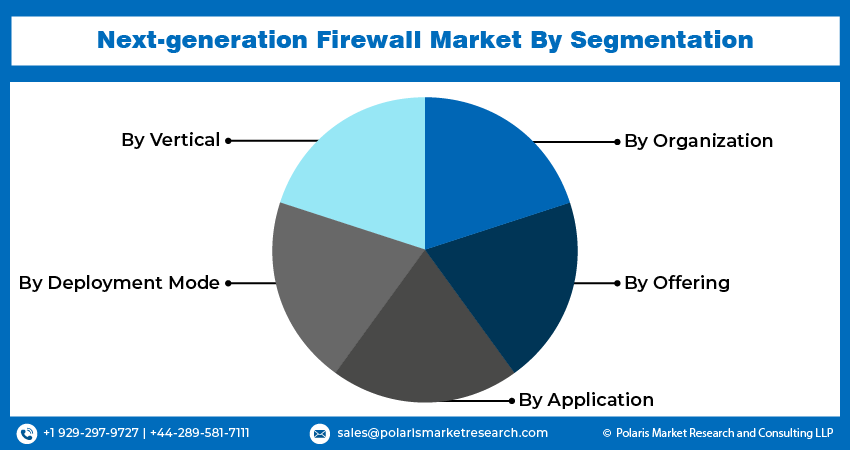
Next-generation Firewall Market Share, Size, Trends, Industry Analysis Report
By Vertical (Manufacturing, Healthcare, BFSI); By Deployment Mode; By Organization Size; By Offering; By Application; By Region; Segment Forecast, 2024- 2032
- Published Date:Mar-2024
- Pages: 116
- Format: PDF
- Report ID: PM4714
- Base Year: 2023
- Historical Data: 2019 – 2022
Report Outlook
Global next-generation firewall market size was valued at USD 4.79 billion in 2023. The market is anticipated to grow from USD 5.18 billion in 2024 to USD 11.78 billion by 2032, exhibiting the CAGR of 10.8% during the forecast period
Next-generation Firewall Market Overview
Next-generation firewalls (NGFWs) represent the most recent advancement in firewall technology, offering more than just basic packet filtering by incorporating additional network security features. NGFWs are available in two primary forms: hardware-based appliances and software-based virtual machines, which can be deployed on standard servers. In the rapidly evolving cybersecurity landscape, there is a growing emphasis on regulatory compliance, which is driving NGFW market players such as Palo Alto Networks, Cisco, and Fortinet to enhance their offerings. These next-generation firewall market players are integrating features like application control and intrusion prevention into their NGFWs to help organizations comply with regulations and protect against advanced threats.
- For instance, in September 2023, Cisco introduced the Secure Firewall 4200 Series appliances and Threat Defense 7.4 software, bringing advanced capabilities to modern firewalling. These new offerings utilize inference-based traffic classification and collaboration across the Cisco portfolio, addressing the challenges posed by hybrid work environments and encrypted traffic profiles. They provide enhanced threat visibility and streamline operations for improved security.

To Understand More About this Research:Request a Free Sample Report
Application control allows organizations to monitor and control the applications that are allowed to access the network, helping to prevent unauthorized access and data breaches. Intrusion prevention systems (IPS) are designed to detect and block malicious activity on the network, providing an additional layer of security against cyber threats. By incorporating these features into their NGFWs, providers are helping organizations stay compliant with regulations while also improving their overall cybersecurity posture.
With the increasing stringency of global data protection laws such as GDPR and CCPA, there is a rising demand for compliance-focused solutions, putting NGFWs market players at the forefront. These providers offer customized solutions that navigate the intricate regulatory environment and protect enterprises from evolving cyber threats.
Next-generation Firewall Market Dynamics
Market Drivers
An Increase in Cyberattacks and Data Breach Incidents
The rise in cyberattacks and data breaches in businesses is driving growth in the global next-generation firewall market demand. These incidents highlight the weaknesses in the current network security infrastructures since they frequently result in the loss of sensitive consumer and company data. To lessen the likelihood of such attacks, next-generation firewalls, or NGFWs, provide advanced threat protection features like malware analysis, application control, and intrusion prevention. Compared to traditional firewalls, their integrated security features offer higher protection.
Additionally, businesses are forced to implement NGFWs due to rules implemented by numerous governments globally about data security and privacy. For instance, the FBI's Internet Crime Complaint Center released its 2020 Internet Crime Report, There were 791,790 complaints related to suspected Internet crimes in 2020, representing an increase of over 300,000 complaints from the 2019. These complaints also reported total losses exceeding US$4.2 billion.
The demand for next-generation firewall solutions is driven by an increase in remote work.
The rise of remote work has increased the need for advanced security solutions, especially next-generation firewalls. This trend has emphasized the importance of strong protection against evolving cyber threats in a decentralized workforce environment. NGFWs, which feature advanced threat detection and prevention capabilities, are crucial for protecting organizations’ networks and data. As phishing attacks targeting remote employees continue to increase, the importance of implementing sophisticated security measures is more evident than ever. For instance, in March 2022, a report by Alliance Virtual Offices explains an astonishing surge in cyberattacks amid the COVID-19 epidemic of 238%. Companies deliberately implement cutting-edge NGFW solutions, such as Cisco Secure Firewall and Barracuda CloudGen Firewall, to address these issues and ensure secure data transmission and remote access in the rapidly changing remote work environment.

Market Restraints
Developments in machine learning and artificial intelligence are likely to impede the market growth.
AI and machine learning empower security solutions to analyze vast amounts of data in real time, identifying unknown threats and anomalies without predefined rules or signatures. They can learn from past incidents, enhancing their capabilities over time. This self-learning aspect makes AI-driven security more predictive and preemptive against new cyber threats, unlike traditional next-generation firewalls that rely on predefined rules and patterns. Additionally, AI security solutions automate threat hunting across networks, autonomously analyzing logs and behaviors to detect potential security issues. This automation and continuous learning significantly improve organizations' threat detection and response capabilities, reducing the manual efforts required compared to traditional firewalls.
Report Segmentation
The market is primarily segmented based on vertical, deployment mode, organization, offering, application and region.
|
By Vertical |
By Deployment Mode |
By Organization |
By Offering |
By Application |
By Region |
|
|
|
|
|
|
To Understand the Scope of this Report:Speak to Analyst
Next-generation Firewall Market Segmental Analysis
By Vertical Analysis
- The healthcare segment is projected to grow at the fastest CAGR during the projected period. Healthcare organizations are increasingly relying on technology to store and transmit sensitive patient data, making them vulnerable to cyberattacks. Next-generation firewalls market development offers advanced security features such as intrusion detection, deep packet inspection, and application control to protect this data. Stricter regulations like HIPAA in the US and GDPR in Europe require strong data security measures, highlighting the need for NGFWs to ensure compliance. The proliferation of connected medical devices and wearables creates more entry points for attackers, emphasizing the importance of NGFWs in securing these devices and networks. Healthcare organizations are investing in cybersecurity solutions like NGFWs to strengthen their defenses and protect patient data, driving a significant boom in this sector.
By Deployment Mode Analysis
- The cloud/virtual segment is expected to grow at the fastest growth rate over the coming years. Since it addresses vital business demands, cloud-based NGFWs are propelling growth in the next-generation firewall market forecast period. These systems are scalable and agile, easily adjusting to changing security requirements and dynamic situations. They become more economical for enterprises by doing away with specific hardware, which also lowers power consumption, maintenance costs, and upfront expenditures. Additionally, cloud deployment streamlines management, freeing IT personnel to concentrate on important security projects. Furthermore, secure remote access is made possible by cloud-based NGFWs, which is advantageous for companies with distributed workforces. Because of its quick updates, threat detection capabilities, and easy interaction with other cloud-based security solutions, cloud/virtual deployment is the NGFW market opportunity with the quickest rate of growth. These factors help to create a comprehensive cybersecurity posture.

Next-generation Firewall Market Regional Insights
The North America region dominated the global market with the largest market share in 2023
The North America region dominated the global market with the largest market share in 2023 and is expected to maintain its dominance over the next generation firewall market forecast period. The presence of leading NGFW vendors such as Fortinet, Check Point Software Technologies, and Palo Alto Networks creates a thriving ecosystem for NGFW market development and adoption. Furthermore, stringent data security regulations such as GBLA, CISA, GDPR and HIPAA are driving the boom of advanced technologies such as NGFWs market demand in this region. With a high IT spending capacity and mature cybersecurity awareness, businesses in the region readily invest in sophisticated NGFW solutions to protect critical data against evolving cyber threats. Additionally, the high rate of cloud adoption in North America contributes to the demand for cloud-based NGFW deployments, consolidating the region's position as a key player in the NGFW market development.
The Asia Pacific region is expected to be the fastest growing region, with a healthy CAGR during the projected period. The region's increasing adoption of cloud platforms and Internet of Things (IoT) devices as part of government initiatives is fueling the demand for next-generation firewalls (NGFWs) market growth. These technologies offer efficiency and scalability benefits but also introduce new security challenges. Additionally, tightening cybersecurity rules and regulations are prompting governments to invest in advanced security solutions like NGFWs to protect their data and infrastructure. NGFWs provide enhanced threat detection and prevention capabilities, including the ability to inspect and filter traffic at the application layer, making them crucial for securing government networks in an increasingly connected environment.

Competitive Landscape
The next-generation firewall market development is fragmented and is anticipated to witness competition due to several players' presence. Major service providers in the market are constantly upgrading their technologies to stay ahead of the competition and to ensure efficiency, integrity, and safety. These players focus on partnership, product upgrades, and collaboration to gain a competitive edge over their peers and capture a significant market share.
Some of the major players operating in the global market include:
- Barracuda Networks
- Cato Networks
- Check Point
- Cisco
- CrowdStrike
- Forcepoint
- Fortinet
- Hillstone Networks
- Juniper Networks
- NordLayer
- Palo Alto Networks
- SonicWall
- Trend Micro
- Versa Networks
- Zscaler
Recent Developments
- In May 2023, Palo Alto Networks introduced the Cloud NGFW for Azure, which integrates its ML-powered next-generation Firewall into a fully managed Azure-native ISV service. This solution includes Advanced Threat Prevention, URL Filtering, WildFire, and DNS Security powered by AI and ML. It effectively stops known, unknown, and zero-day threats, making it easier and more secure to migrate applications to Microsoft Azure.
- In October 2022, Clavister, a European cybersecurity firm specializing in mission-critical applications, announced the renewal of its longstanding partnership with Nokia. This collaboration is focused on addressing the growing need for 5G security. As part of this renewed agreement, Clavister's NetShield solution will be integrated into Nokia's Managed Firewall Services (MFS) and Managed Security Services (MSS).
Report Coverage
The next-generation firewall market report emphasizes on key regions across the globe to provide better understanding of the product to the users. Also, the report provides market insights into recent developments, trends and analyzes the technologies that are gaining traction around the globe. Furthermore, the report covers in-depth qualitative analysis pertaining to various paradigm shifts associated with the transformation of these solutions.
The report provides detailed analysis of the market while focusing on various key aspects such as competitive analysis, vertical, deployment mode, organization, offering, application, and their futuristic growth opportunities.
Next-generation Firewall Market Report Scope
|
Report Attributes |
Details |
|
Market size value in 2024 |
USD 5.18 billion |
|
Revenue forecast in 2032 |
USD 11.78 billion |
|
CAGR |
10.8% from 2024 – 2032 |
|
Base year |
2023 |
|
Historical data |
2019 – 2022 |
|
Forecast period |
2024 – 2032 |
|
Quantitative units |
Revenue in USD billion and CAGR from 2024 to 2032 |
|
Segments covered |
By Vertical, By Deployment Mode, By Organization, By Offering , By Application, By Region |
|
Regional scope |
North America, Europe, Asia Pacific, Latin America; Middle East & Africa |
|
Customization |
Report customization as per your requirements with respect to countries, region and segmentation. |
FAQ's
The Next-generation Firewall Market report covering key segments are vertical, deployment mode, organization, offering, application and region.
Next-generation Firewall Market Size Worth $11.78 Billion By 2032
Next-generation Firewall Market exhibiting the CAGR of 10.8% during the forecast period
North America is leading the global market
key driving factors in Next-generation Firewall Market are Increase in Cyberattacks and Data Breach Incidents
